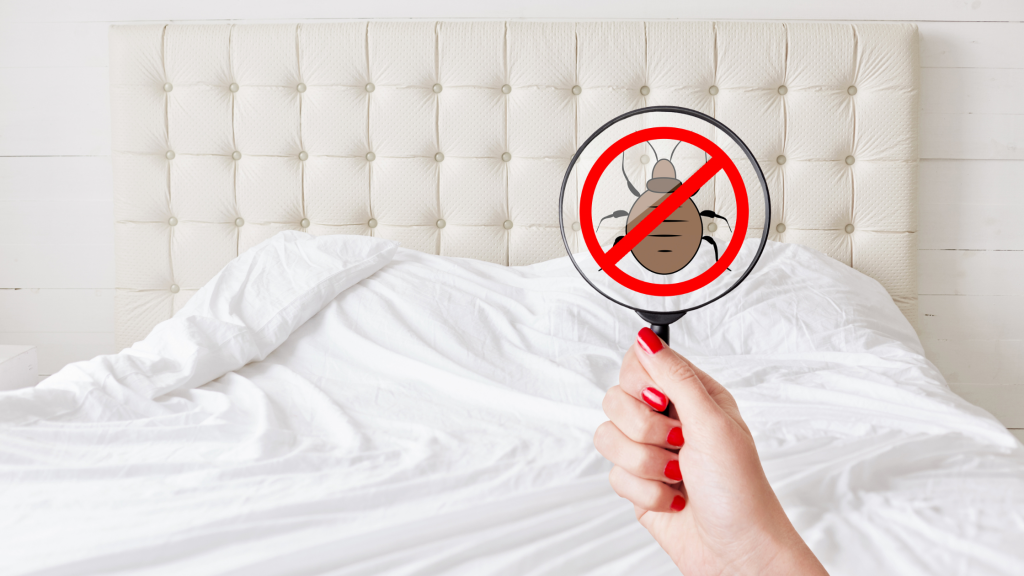
Preventing Bed Bugs While Traveling
The year is often filled with travel adventures – from summer vacations to holiday visits with the family and even work trips. Amidst these travels, it’s important to be aware of a common pest – bed bugs! Read about signs and tips on preventing bed bugs while traveling.
Recognizing Bed Bugs: Know the Signs
Bed bugs are nocturnal, and will sustain themselves off the blood of a host. They feed where they sleep and rest, such as in beds, box springs, bed frames, and upholstered furniture. They are reddish brown and have a flat, oval-shaped body that is the size of an apple seed. During the day, they hide in the cracks and crevices of the sleeping areas of the hosts so they can stay undisturbed and females can continue to reproduce. In a female’s lifetime, they can lay hundreds of eggs in secluded areas and the eggs will then take 1-2 weeks to hatch.
Here are common signs of bed bugs you will want to look out for:
- Bites – When a bed bug is feeding, it will bite its host. The bites usually appear after a day or two and appear in clusters or a line on the skin. They are small and red and can become inflamed or irritated.
- Blood stains and dark spots – When bed bugs are present, they will leave blood stains on pillowcases and sheets, after being squished while someone is sleeping. They will also leave feces that are dark spots on mattresses, bedding, or furniture.
- Odor and shed skins – In severe infestations, a bed bug’s scent glands will leave a musty odor in the areas that they are in and while they grow, they shed from their skin leaving behind a translucent and empty exoskeleton.
Tips to Prevent Bed Bugs While Traveling
While traveling, it’s important to keep your belongings safe. Learn some tips to implement in your day-to-day tasks.
- Inspect your accommodation – When arriving at your destination, before bringing your belongings into the room, it’s important to inspect the furniture and bedding. Use a flashlight to see in dark areas. Search in areas like behind the headboard, in the furniture, along the seams of a mattress, and keep an eye out for signs like dark spots, shed skin, or a live bed bug.
- Use luggage racks – Luggage racks or hardwood surfaces are spaces less likely to harbor bed bugs, which is why placing your belongings on them is better than keeping them on the bed or the floor itself.
- Seal your belongings – Keeping your belongings, like clothes, shoes, and other important items in resealable plastic bags or containers while you travel will prevent bed bugs from getting to them.
- Wash and dry your clothes – Before bringing your belongings back inside your home, wash all linens and dry them on high heat for at least 45 minutes. Washing with hot water and drying at high heat is important, as bed bugs and their eggs will die off since they are sensitive to high temperatures. After that, inspect the belongings that cannot be washed to ensure they are bed bug-free.
Actions to Take
Bed bugs are among the pests that are the most easily transferable from home to home, and they are more common than people realize. If you experience any activity present at your home, here are some tips to help manage them.
- Consult with a pest control company – As many at-home remedies as there are, bed bugs can still be a very difficult pest to control and fully eradicate. Consulting with a licensed and professional pest expert is important as they can determine the amount of activity and know what chemicals and steps to proceed with. Along with any treatments that we do, we include a checklist of things to do to make your home bed bug-free.
- Clean, clean, clean – While treatment is being conducted, there are important cleaning tasks to complete. Vacuuming, washing and drying clothes, removing belongings, and having protective covers over your mattress and belongings, will make the process easier and create an environment where bed bugs are unable to sustain themselves.
- Monitor and follow up – Monitoring areas around your home that had bed bug activity, including during and after treatment, is important. Along with this, completing post-treatment tasks will help prevent worsening any activity or having an infestation at your home.
Staying vigilant and continuing your tasks to keep yourself bed bug-free is important. If you have any questions about bed bugs or believe you are experiencing some activity, contact our office at (844) 572-0628
